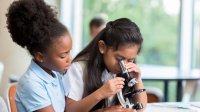Using Learning Progressions to Guide Science Teaching
Teachers can use learning progressions to give students a framework to build on their science knowledge, fostering curiosity and enthusiasm.
Your content has been saved!
Go to My Saved Content.Not so long ago, one of the most common approaches to science instruction involved lectures with a content focus, students memorizing discrete facts, and confirmation inquiry that was delivered through the scientific method. We employed this line of instruction, as did many of our colleagues.
How has this line of instruction changed in the vast majority of classrooms today? What should science instruction look and sound like in today’s classroom? With the Next Generation Science Standards (NGSS), students should be taking control of authentic experiences, scientific practices, and skills.
In our experience as STEAM professional development specialists, the NGSS ignited students’ curiosity and love for science. This type of science teaching and learning allows students to behave like professional scientists in the field as they use scientific behaviors to explain a scientific phenomenon.
This has presented some challenges for teachers as they shift their mindset around science teaching and learning. To support teachers and students, we created student-friendly learning progressions aligned to the Science and Engineering Practices, what scientists do. This allows students to authentically engage with, develop a deeper understanding of, and apply science knowledge in real-world situations.
Before introducing the framework to students, it’s important that teachers have a clear understanding of the expectations of the science and engineering practices. Teachers can develop their understanding of these practices through the development and understanding of the performance expectations, or learning objectives, of NGSS. NSTA (the National Science Teaching Association) and NGSS have created a learning progression matrix aligned to each of the science and engineering practices. This is a great resource for teachers, but our goal is always to be as student centered as possible.
With that understanding, we created student-friendly anchor charts and student-friendly learning progressions in alignment with the teacher’s learning progression matrix. We use these with our kindergarten through eighth-grade teachers and students. Ironically, our teachers have grown to like the student-friendly version better than the actual matrix. Using these resources coupled with a routine or framework will propel science students to success.
How to get started
When teachers follow the routine below, it ensures that students can authentically meet the expectations of “what scientists do.” This framework promotes deeper scientific understanding for both the teacher and the student.
1. Set up a science notebook. We begin the year by setting up science notebooks. We let the students know that they’ll be using their science notebooks to curate all of their learning.
2. Make anchor charts visible. Student-friendly anchor charts are a great way to launch your students’ initial understanding of the science and engineering practices.
3. Introduce the student-friendly science and engineering practice learning progressions. One of the early science notebook entries for students is adding the library of the student-friendly progressions. We teach students how these represent “what scientists do.” Students learn the various ways they may interact with the progressions.
4. Give explicit instruction on the various ways to interact with the progressions.
- Self-assessment and goal-setting: Students use learning progressions to self-assess their understanding of the science and engineering practices. By comparing their own performance with the expectations at each level of the progression, students can identify areas where they need to improve and set goals for themselves. This can help motivate students to engage in the science and engineering practices and work toward improving their skills.
- Reflection: Students use learning progressions to reflect on their learning and identify areas of strength and weakness. By reflecting on their own performance and progress, students can better understand their own learning process and take ownership of their learning.
- Asking for feedback: Students use learning progressions to ask for feedback from teachers or peers. By understanding the expectations at each level of the progression, students can ask specific questions and seek feedback that’s targeted to their own needs.
- Collaborating with peers: Students use learning progressions to collaborate with peers and support each other’s learning. By working together to identify areas of strength and weakness, students can provide each other with feedback and support that helps them make progress in their scientific thinking and engineering design skills.
5. Monitor student learning. As the students take the lead in tracking their work through the use of learning progressions, teachers use a single point rubric to have conferences and facilitate discussions to move students along the progressions. They do the following:
- Periodically review students’ notebooks to assess their progress and provide feedback on their work.
- Use formative assessments, such as quizzes and exit tickets, to track student progress on specific science and engineering practices.
- Ask students to assess each other’s work using criteria that align with the science and engineering practices.
- Use the learning progressions to plan instruction and provide feedback that’s appropriate for students at different levels of development. By designing lessons that build on students’ prior knowledge and skills, teachers can help students make progress in their scientific thinking and engineering design abilities.
We’ve found that student-friendly science and engineering learning progressions are essential tools for effective teaching and learning. The progressions provide a clear and structured framework for students to develop their understanding of scientific concepts and engineering principles and to build on this knowledge over time. They help educators to design learning experiences that are engaging, relevant, and aligned with students’ abilities and prior knowledge.
These progressions also support students in developing the critical thinking, problem-solving, and communication skills that are essential for success in STEM fields and beyond. By using student-friendly science and engineering learning progressions, teachers can help learners to develop a deep and lasting appreciation for the wonders of the natural world and the power of human ingenuity to solve complex problems.
